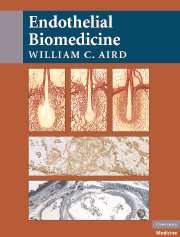Book contents
- Frontmatter
- Contents
- Editor, Associate Editors, Artistic Consultant, and Contributors
- Preface
- PART I CONTEXT
- PART II ENDOTHELIAL CELL AS INPUT-OUTPUT DEVICE
- PART III VASCULAR BED/ORGAN STRUCTURE AND FUNCTION IN HEALTH AND DISEASE
- PART IV DIAGNOSIS AND TREATMENT
- 172 Introductory Essay: Diagnosis and Treatment
- 173 Circulating Markers of Endothelial Function
- 174 Blood Endothelial Cells
- 175 Endothelial Microparticles: Biology, Function, Assay and Clinical Application
- 176 Molecular Magnetic Resonance Imaging
- 177 Real-Time Imaging of the Endothelium
- 178 Diagnosing Endothelial Cell Dysfunction
- 179 Statins
- 180 Steroid Hormones
- 181 Organic Nitrates: Exogenous Nitric Oxide Administration and Its Influence on the Vascular Endothelium
- 182 Therapeutic Approaches to Altering Hemodynamic Forces
- 183 Stent- and Nonstent-Based Cell Therapy for Vascular Disease
- 184 Building Blood Vessels
- 185 Gene Transfer and Expression in the Vascular Endothelium
- 186 Drug Targeting to Endothelium
- PART V CHALLENGES AND OPPORTUNITIES
- Index
- Plate section
185 - Gene Transfer and Expression in the Vascular Endothelium
from PART IV - DIAGNOSIS AND TREATMENT
Published online by Cambridge University Press: 04 May 2010
- Frontmatter
- Contents
- Editor, Associate Editors, Artistic Consultant, and Contributors
- Preface
- PART I CONTEXT
- PART II ENDOTHELIAL CELL AS INPUT-OUTPUT DEVICE
- PART III VASCULAR BED/ORGAN STRUCTURE AND FUNCTION IN HEALTH AND DISEASE
- PART IV DIAGNOSIS AND TREATMENT
- 172 Introductory Essay: Diagnosis and Treatment
- 173 Circulating Markers of Endothelial Function
- 174 Blood Endothelial Cells
- 175 Endothelial Microparticles: Biology, Function, Assay and Clinical Application
- 176 Molecular Magnetic Resonance Imaging
- 177 Real-Time Imaging of the Endothelium
- 178 Diagnosing Endothelial Cell Dysfunction
- 179 Statins
- 180 Steroid Hormones
- 181 Organic Nitrates: Exogenous Nitric Oxide Administration and Its Influence on the Vascular Endothelium
- 182 Therapeutic Approaches to Altering Hemodynamic Forces
- 183 Stent- and Nonstent-Based Cell Therapy for Vascular Disease
- 184 Building Blood Vessels
- 185 Gene Transfer and Expression in the Vascular Endothelium
- 186 Drug Targeting to Endothelium
- PART V CHALLENGES AND OPPORTUNITIES
- Index
- Plate section
Summary
Gene transfer to the endothelium represents a potentially powerful Approach to research and therapy. Interest in gene transfer and expression has grown apace with the evolving understanding of the importance of the endothelium in many biological and pathological processes, as detailed elsewhere in this volume. The technological advances that have made efficient gene transfer to living cells possible are relatively recent, and therefore gene transfer to the endothelium is still a somewhat immature field with substantial technical challenges still unresolved. This is particularly true with regard to in vivo gene transfer to the vascular endothelium of an intact organism.
Transfer and expression of foreign DNA to a living cell requires two components: (a) a vector to carry, protect, and traffic the foreign DNA, and (b) a DNA sequence which, once inside the host cell, is capable of interacting with the host cell's translational machinery. In nature, this process can occur in single-cell organisms by means of transformation, but it occurs in mammalian cells efficiently only by viruses. Therefore, the advent of recombinant viruses, produced by means of molecular engineering, brought gene transfer into the scientific mainstream.
As an intact organ, the endothelium has greater access to the vascular compartment than any other cell or tissue type. Therefore, the endothelium is the first point of contact between a gene-delivery vector administered to the vascular compartment and the host. For this reason, it presents an accessible target of opportunity for systemically administered gene-delivery vectors. Conversely, the intimate relationship between the endothelium and the intravascular compartment mandates careful consideration of unintended consequences of the interaction between the endothelium and a systemically administered gene-delivery vector.
The history of attempts to transfer genetic payloads to the endothelium has clearly been technology-limited.
- Type
- Chapter
- Information
- Endothelial Biomedicine , pp. 1725 - 1733Publisher: Cambridge University PressPrint publication year: 2007

